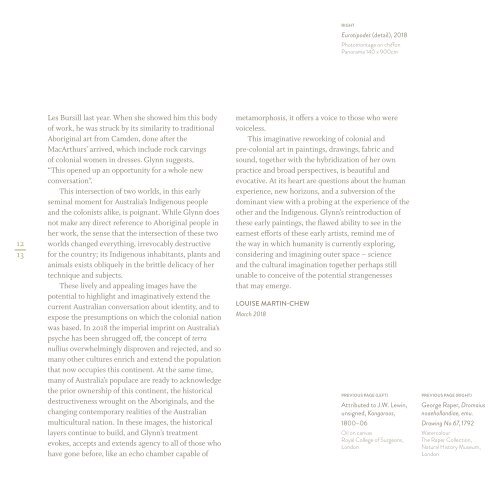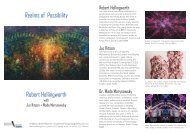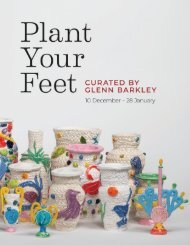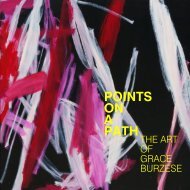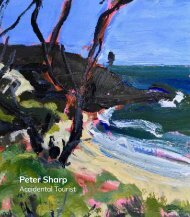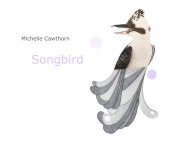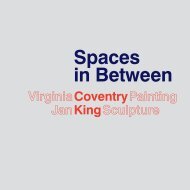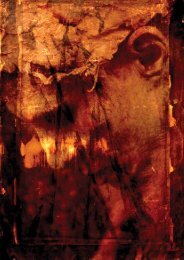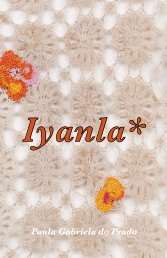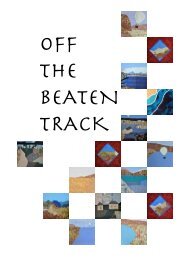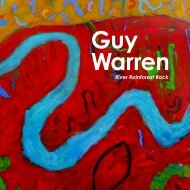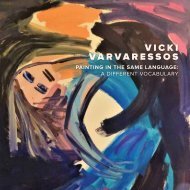Promiscuous Provenance Exhibition catalogue
Exhibition by artist Anna Glynn, on show at Shoalhaven Regional Gallery and touring nationally 2018-2021.
Exhibition by artist Anna Glynn, on show at Shoalhaven Regional Gallery and touring nationally 2018-2021.
You also want an ePaper? Increase the reach of your titles
YUMPU automatically turns print PDFs into web optimized ePapers that Google loves.
RIGHT<br />
Eurotipodes (detail), 2018<br />
Photomontage on chiffon<br />
Panorama 140 x 900cm<br />
12<br />
13<br />
Les Bursill last year. When she showed him this body<br />
of work, he was struck by its similarity to traditional<br />
Aboriginal art from Camden, done after the<br />
MacArthurs’ arrived, which include rock carvings<br />
of colonial women in dresses. Glynn suggests,<br />
“This opened up an opportunity for a whole new<br />
conversation”.<br />
This intersection of two worlds, in this early<br />
seminal moment for Australia’s Indigenous people<br />
and the colonists alike, is poignant. While Glynn does<br />
not make any direct reference to Aboriginal people in<br />
her work, the sense that the intersection of these two<br />
worlds changed everything, irrevocably destructive<br />
for the country; its Indigenous inhabitants, plants and<br />
animals exists obliquely in the brittle delicacy of her<br />
technique and subjects.<br />
These lively and appealing images have the<br />
potential to highlight and imaginatively extend the<br />
current Australian conversation about identity, and to<br />
expose the presumptions on which the colonial nation<br />
was based. In 2018 the imperial imprint on Australia’s<br />
psyche has been shrugged off, the concept of terra<br />
nullius overwhelmingly disproven and rejected, and so<br />
many other cultures enrich and extend the population<br />
that now occupies this continent. At the same time,<br />
many of Australia’s populace are ready to acknowledge<br />
the prior ownership of this continent, the historical<br />
destructiveness wrought on the Aboriginals, and the<br />
changing contemporary realities of the Australian<br />
multicultural nation. In these images, the historical<br />
layers continue to build, and Glynn’s treatment<br />
evokes, accepts and extends agency to all of those who<br />
have gone before, like an echo chamber capable of<br />
metamorphosis, it offers a voice to those who were<br />
voiceless.<br />
This imaginative reworking of colonial and<br />
pre-colonial art in paintings, drawings, fabric and<br />
sound, together with the hybridization of her own<br />
practice and broad perspectives, is beautiful and<br />
evocative. At its heart are questions about the human<br />
experience, new horizons, and a subversion of the<br />
dominant view with a probing at the experience of the<br />
other and the Indigenous. Glynn’s reintroduction of<br />
these early paintings, the flawed ability to see in the<br />
earnest efforts of these early artists, remind me of<br />
the way in which humanity is currently exploring,<br />
considering and imagining outer space – science<br />
and the cultural imagination together perhaps still<br />
unable to conceive of the potential strangenesses<br />
that may emerge.<br />
LOUISE MARTIN-CHEW<br />
March 2018<br />
PREVIOUS PAGE (LEFT)<br />
Attributed to J.W. Lewin,<br />
unsigned, Kangaroos,<br />
1800–06<br />
Oil on canvas<br />
Royal College of Surgeons,<br />
London<br />
PREVIOUS PAGE (RIGHT)<br />
George Raper, Dromaius<br />
noaehollandiae, emu.<br />
Drawing No 67, 1792<br />
Watercolour<br />
The Raper Collection,<br />
Natural History Museum,<br />
London


